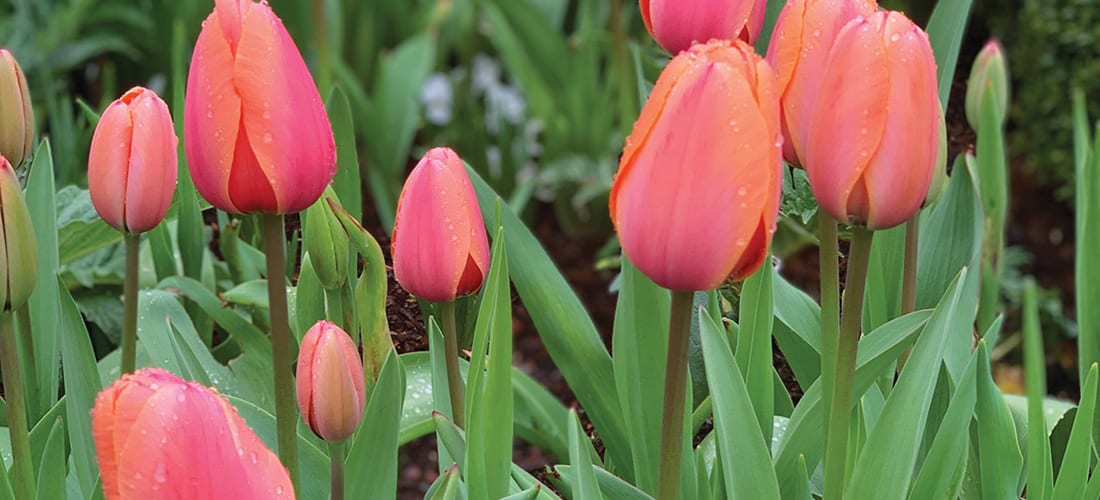Home for spring
March 1, 2021

With its long-lasting show of flowers, Charlotte shines in springtime.
by Laurie Durden
In her book, A Southern Garden, Elizabeth Lawrence wrote:
“I do not suppose there is any part of the world in which gardens are not beautiful in spring. Travellers in other seasons are told, ‘you should see our gardens in spring.’ To which they reply, ‘but we cannot leave our own then.’”
This surely rings true to me — I want to be home for spring. Springtime in the Queen City is especially wonderful, not only because it is gorgeous, but also because it lasts so long. Spring’s blooming season begins in February and continues through May. I may be biased, but I would argue that Charlotte’s spectacular show of flowers and foliage rivals any landscape, anywhere.

As a garden designer, I am typically installing clients’ gardens in spring in a race to beat the onset of the summer heat. I’m usually too busy to even think about my own garden. Last year, the Covid-19 lockdown changed all that, and I found out what I was missing. It truly was a silver lining to have the opportunity to set up my studio on the back porch, where I could watch spring unfold over hours, days, weeks and months. Everyday there was something new. I could literally see time passing, when it otherwise felt like time had completely stopped still.
When we begin the design of a new garden, we first stress the importance of establishing the bones, with walls, evergreen shrubs and trees. These permanent elements provide a framework for the fleeting seasonal displays. Flowering trees, shrubs and vines establish a dependable rhythm to the garden, each coming into play in its own way as a part of the spring garden dance. The addition of spring flowering bulbs can turn a carefully choreographed garden waltz of spring flowers into a boogie-down disco of unexpected delight.
My own garden has been my laboratory for nearly 17 years, and my favorite research and development project is spring bulbs. I affectionately refer to this as ‘Tulip Testing,’ though I should note that this exercise is not limited to tulips — you can experiment with any flowering bulbs. It started more than 12 years ago when I was selecting bulbs for a special project and found I was completely overwhelmed by the vast selections available in catalogs. It was easy enough to select a color palette, but then I realized there are countless shapes and sizes; early, mid-season and late bloomers; and so many more intriguing options.






Gardening is learned by doing, so I ordered a couple hundred curiosities to try out in the back corner of my garden. I was hooked from the moment they went into the ground. Anticipation is a gardener’s greatest tonic. From the moment bits of foliage pushed through the earth, I regularly monitored the progress.
I’ve conducted ‘Tulip Testing’ each year since, and while I confess it is not very scientific, I have learned a great deal. This year, I planted many more hundreds and, like every year, I wish I had planted more. (PSA: You cannot plant too many bulbs.) Now, I can confidently plant my formal garden beds and containers to bloom in a sequence that mostly goes according to script and is beautiful from early March through mid-May. The season begins with a warm palette of tulips in the bare, early spring landscape and evolves into white and cool colors as the new foliage of shrubs and trees fills out the garden.
This planned progression of my favorites certainly brings joy, but the real fun is in the back of the garden behind a hedge, in a large planting bed where a swing set used to be. This testing garden is where I plant my tried-and-true favorites for cutting, along with new selections to evaluate for color, character, height, bloom time and length of bloom.
The best part of this annual experiment is having flowers to bring inside all season long — and, especially, having a surplus to share. With minimal effort, you can fill your home and the homes of your friends with flowers all spring. While I love tulips from the grocery store, trust me when I tell you that tulips grown in your own garden are way better and don’t take much more effort.
This spring, my charge to all aspiring and seasoned gardeners alike is to pay attention: Make notes, and take photos, so that come September, you can confidently order bulbs for your own version of ‘Tulip Testing.’ SP
Laurie Durden is a garden designer based in Charlotte.
ldgardendesign.com
Beautiful bulbs
Here are a few of Durden’s tried-and-true favorite spring bulbs.
Pre-spring
Crocus, Snowdrops, Hyacinths
Early spring
Glory of the Snow; Squill; Daffodil ‘Ice Follies’ and ‘Barrett Browning;’ Tulip ‘Apricot Beauty’ and ‘Purissima’
Mid-spring
Daffodil ‘Actaea’ and ‘Thalia;’ Summer Snowflake; Grape Hyacinth; Tulip ‘Ivory Floradale,’ ‘Pink Impression,’ ‘Shirley,’ ‘Negrita’ and ‘Big Apricot’
Late spring
Camassia; Spanish Bluebells; Tulip ‘Maureen,’ ‘Queen of the Night,’ ‘Elegant Lady,’ ‘Menton’ and ‘Angelique’
Almost summer
Allium ‘Pink Jewel’




